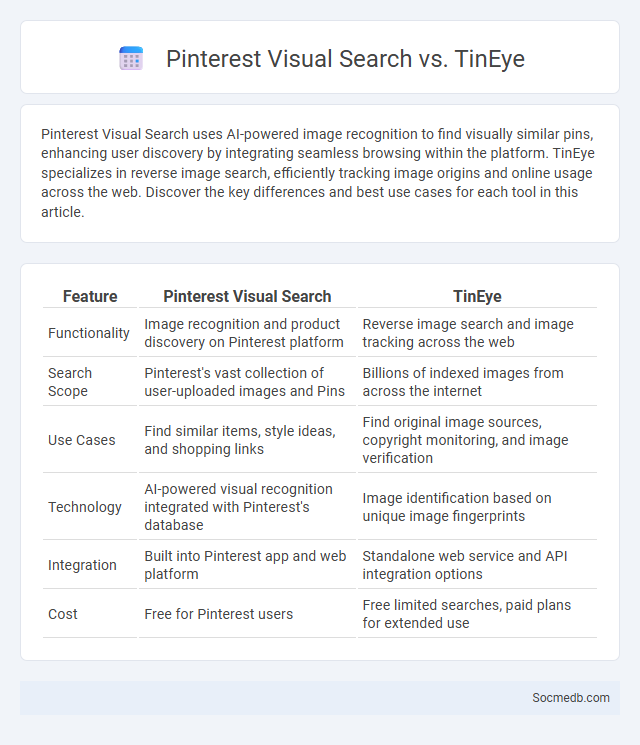
Photo illustration: Pinterest Visual Search vs TinEye
Pinterest Visual Search uses AI-powered image recognition to find visually similar pins, enhancing user discovery by integrating seamless browsing within the platform. TinEye specializes in reverse image search, efficiently tracking image origins and online usage across the web. Discover the key differences and best use cases for each tool in this article.
Table of Comparison
| Feature | Pinterest Visual Search | TinEye |
|---|---|---|
| Functionality | Image recognition and product discovery on Pinterest platform | Reverse image search and image tracking across the web |
| Search Scope | Pinterest's vast collection of user-uploaded images and Pins | Billions of indexed images from across the internet |
| Use Cases | Find similar items, style ideas, and shopping links | Find original image sources, copyright monitoring, and image verification |
| Technology | AI-powered visual recognition integrated with Pinterest's database | Image identification based on unique image fingerprints |
| Integration | Built into Pinterest app and web platform | Standalone web service and API integration options |
| Cost | Free for Pinterest users | Free limited searches, paid plans for extended use |
Introduction to Visual Search Technologies
Visual search technologies transform how you interact with social media by enabling image-based searches rather than relying solely on text. These technologies use advanced machine learning algorithms and computer vision to identify objects, products, or scenes within images, offering more accurate and intuitive search results. Leveraging visual search can enhance user engagement and streamline content discovery on platforms like Instagram, Pinterest, and Snapchat.
Understanding Pinterest Visual Search
Pinterest visual search leverages advanced image recognition technology to identify objects within pins, enabling users to discover related content effortlessly. By analyzing pin visuals, the platform enhances user engagement through personalized recommendations and shoppable ideas. This technology boosts brand visibility by connecting users directly with relevant products and inspiration based on visual similarity.
Overview of TinEye Image Search
TinEye Image Search provides a reverse image search engine that enables users to find the origin and usage of images across the web. Leveraging advanced image recognition technology, TinEye indexes billions of images to deliver precise matches, tracking image copies, modifications, and derivatives. Marketers and content creators use TinEye to monitor brand exposure, verify image authenticity, and protect intellectual property on social media platforms.
Defining General Visual Search Engines
General visual search engines use advanced image recognition algorithms to analyze and identify objects within photos and videos across social media platforms. These engines enable you to search for content using images instead of keywords, enhancing the discovery of products, places, or trends visually. Leveraging features like deep learning and AI, they provide accurate results by matching visual elements with vast databases.
Key Features Comparison
Social media platforms offer diverse key features including content sharing, real-time messaging, and customizable privacy settings that cater to varied user preferences. Popular platforms like Facebook emphasize community building through groups and events, while Instagram excels in visual content sharing with filters and stories. Twitter's real-time update feed supports concise communication and trending topic engagement, highlighting distinct functionalities across social networks.
Accuracy and Search Results
Accuracy in social media directly impacts the relevancy and trustworthiness of search results, influencing what content You encounter daily. Algorithms prioritize verified information and user engagement metrics to refine search outcomes, ensuring that Your queries return precise and credible sources. Enhancing accuracy reduces misinformation spread and improves the overall quality of social media platforms' search functionalities.
User Interface and Ease of Use
A well-designed social media platform emphasizes an intuitive User Interface (UI) that allows users to navigate seamlessly through features such as posts, messages, and notifications. Your experience is enhanced by streamlined layouts, clear icons, and responsive design that adapt to various devices, making content creation and engagement straightforward. Prioritizing ease of use reduces friction, encouraging longer sessions and more active participation.
Use Cases and Applications
Social media platforms serve diverse use cases such as brand promotion, customer engagement, and real-time communication, which enable businesses to reach targeted audiences effectively. Influencers leverage these channels for content creation and monetization, while organizations utilize analytics tools to track user behavior and optimize campaigns. Your presence on social media can enhance community building, drive sales conversions, and foster customer loyalty through personalized interactions.
Limitations and Challenges
Social media platforms face significant limitations including privacy concerns, misinformation spread, and algorithmic biases affecting content visibility. Your personal data may be vulnerable to breaches, leading to potential misuse and identity theft. Navigating these challenges requires awareness of platform policies and proactive management of your digital footprint.
Conclusion: Which Visual Search Tool to Choose
Choosing the best visual search tool depends on your specific needs, such as accuracy, platform integration, and ease of use. Pinterest Visual Search excels in discovering lifestyle and fashion items, while Google Lens offers broad recognition across various objects and text. Your decision should align with which social media platform you engage with most and the type of visual content you prioritize.
 socmedb.com
socmedb.com